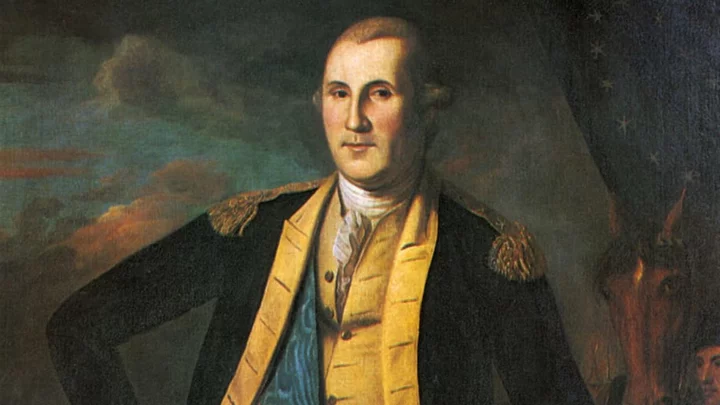When people think of crime and literature, their minds usually turn to Agatha Christie’s novels or true crime books. But there are also some crimes tangled up with books themselves. Below are nine bookish crimes. There’s theft, forgery, and even murder—all with a literary twist.
1. The Hitler Diaries
In 1983, British newspaper The Sunday Times ran a story about the discovery of the so-called Hitler Diaries—60 journals allegedly written by Adolf Hitler. But it was quickly revealed that the diaries had been forged (and not even particularly well) by a man named Konrad Kujau. Not only was the content questionable, but the pages were dyed with tea stains to look aged, and Kujau had mistakenly used a Gothic f instead of an a on the cover for Hitler’s first initial. Later analysis proved that the paper, glue, and bindings were all manufactured after WWII.
Kujau showed the first diary to Fritz Stiefel, a collector of Nazi memorabilia; Stiefel then connected Kujau to Gerd Heidemann, who also collected Nazi artifacts and worked as a journalist at Germany’s Stern magazine. Once Stern bought the diaries for $4.8 million, British distribution rights were sold to The Sunday Times. Hugh Trevor-Roper, Baron Dacre of Glanton, a historian who specialized in Nazi Germany, initially verified the diaries as genuine, but when he did a U-turn before the story went to press, Sunday Times owner Rupert Murdoch declared, “F*** Dacre. Publish.”
As expected, the paper sold well, but at a press conference just one day later, doubts were raised about the authenticity of the journals. When the hoax was revealed, Heidemann claimed in court that he had been deceived by Kujau, while Kujau testified that they were partners in crime. Heidemann ended up being sentenced to four years and eight months in prison, while Kujau got four years and six months. Murdoch faced no negative consequences—in fact, 20,000 of the new readers that the story brought in decided to stick around.
2. The Carnegie Library Heist
Over the course of 25 years, rare books worth $8 million were stolen from the Carnegie Library of Pittsburgh. The huge theft—which included works by Isaac Newton, George Eliot, John Adams, and Elizabeth Cady Stanton—was discovered when the collection was audited in 2017. So much had been stolen over the years that police believed it had to be an inside job.
It soon came to light that Greg Priore, the manager of the library’s Oliver Room, was in cahoots with John Schulman, owner of the nearby Caliban Book Shop. Priore would steal the books (or cut out their illustrations and maps) and, with no one aware that the items were even missing, Schulman would simply stamp them with “Withdrawn from Library” and sell them. Priore and Schulman were sentenced to three and four years’ house arrest, respectively, and 12 years’ probation. Of more than 300 books found vandalized or stolen, 42 were unearthed in Schulman’s warehouse and at least 18 more have since been recovered. Hundreds of the torn-out maps and pages have also been returned.
3. The Murder of Dariusz Janiszewski
Authors often write pieces of themselves into their characters, but after reading Krystian Bala’s Amok, Polish police detective Jacek Wroblewski suspected that the author had penned an actual murder confession. Wroblewski was looking into a cold case from three years earlier: The murder of Dariusz Janiszewski, who was found bound and floating in a lake in 2000. Having discovered that Janiszewski’s missing mobile phone had been sold online by Bala, Wroblewski read Amok—self-published in 2003—and realized that some of the details within the novel matched details of Janiszewski’s murder.
Bala’s estranged wife Stasia had initially been unwilling to talk to police, but after reading sections of Amok, she admitted that Bala had become violent after thinking that she had had an affair with Janiszewski (Stasia told police the pair had gone on a date, but nothing more). Bala was sentenced to 25 years in prison, but maintains that Amok is largely fictional. “It was insane,” he told journalist David Grann during a 2008 interview in prison. “[Wroblewski] treated the book as if it were my literal autobiography.” As for the other evidence pointing towards him, he claims, “I don’t know who yet, but someone is out to destroy me.”
4. The Transy Book Heist
After a freshman orientation tour of Transylvania University, Kentucky, Spencer Reinhard told his friend Warren Lipka (who was attending the University of Kentucky) that millions of dollars’ worth of rare books were sitting in the college’s library with virtually no security. They began plotting a heist—which took place on December 17, 2004—with the help of friends Eric Borsuk and Chas Allen. After setting up an appointment under a fake name to view the books they planned to steal (later valued at more than $5 million), Lipka and Borsuk subdued the librarian out with a stun gun and bound her with zip ties. They loaded the lighter books into their backpacks and the heavier ones into a bed sheet. Reinhard served as lookout, and Allen was in the getaway car.
But things didn’t quite go to plan: Another librarian spotted Lipka and Borsuk as they were leaving and they had to abandon the books in the sheet and flee the scene. They did get away with some books, though, including a first edition of Charles Darwin’s On the Origin of Species (1859) worth $25,000 and a set of Renaissance-era horticultural volumes worth $450,000. They set up a meeting at Christie’s in New York, one of the biggest auction houses in the world. “If we go in there they’re not going to suspect that we stole these,” Reinhard told Vanity Fair in 2007. “Because no one would go to Christie’s with stolen books to get them appraised.”
A couple of critical mistakes led the FBI straight to them, though: First, they used the same email address, which was traced to a computer at the University of Kentucky, to contact the library and Christie’s; second, they gave Christie’s—which was skeptical of the students after meeting with them and so never followed up—their actual phone number at the appointment. Each was sentenced to seven years in prison, but they viewed even that as an escape plan. “Before, in college, growing up, we were being funneled into this mundane, nickel-and-dime existence,” Lipka explained. “Now we can’t ever go back there. … We have no choice now but to create something new, someplace else.”
The movie adaptation of their story, American Animals (2018), features interviews with all four of the robbers that are woven into the narrative.
5. The Wind in the Willows Murder
In 2016, Adrian Greenwood, a historian and art and book dealer, was murdered over his first edition copy of Kenneth Grahame’s The Wind in the Willows (1908). The children’s classic was valued at around £50,000 (roughly $70,000 at the time) and caught the attention of Michael Danaher after he met Greenwood at an auction. Danaher later went to Greenwood’s home in Oxford and stabbed him 16 times. He stole the rare book, stopped to take a selfie outside of his victim’s house, and then put the novel up for sale on eBay. Danaher was arrested just a few days later and sentenced to at least 34 years in prison.
6. Clifford Irving’s Fake Autobiography of Howard Hughes
Eccentric billionaire Howard Hughes became reclusive in his later life, which led author Clifford Irving to believe that he could write a fake autobiography for Hughes without the man himself coming forward to debunk it. Irving forged letters in Hughes’s handwriting to convince publisher McGraw-Hill that he was going to ghost write Hughes’s autobiography, for which they paid an advance of $750,000. (Irving also obtained $250,000 from Life magazine for serial rights and $400,000 for paperback rights.) But contrary to Irving’s belief, Hughes did emerge from the shadows—or, rather, his voice did, first via a representative and then on a conference call with journalists—to expose the autobiography as false. Irving and his wife, who was in on the scam, confessed to the crime in January 1972, and both served time in prison.
When Irving was released after 17 months, he said, “I hope the world forgets. I’d hate to go to my grave remembered only as the man who did the Hughes hoax.” And yet, Irving promoted and profited off his crime, detailing the whole plan in Clifford Irving: What Really Happened (1972), which was reissued nine years later as The Hoax. He also sold the rights to the Richard Gere-led film adaptation, also titled The Hoax (2006). Irving disputed the accuracy of the movie, describing it as “a hoax about a hoax.”
7. The Murder of John Lennon
One of the most famous crimes that has been linked to literature is the murder of John Lennon. Mark David Chapman was captivated by J.D. Salinger’s The Catcher in the Rye (1951) and had a copy of the novel on him when he gunned down The Beatles musician in New York City on December 8, 1980. (“This is my statement,” he’d written inside. He also added a signature: “Holden Caufield.”)
Chapman cited a number of reasons for the murder, including his religious faith and irritation with Lennon (“I would get angry at him for saying [in the song ‘God’] that he didn’t believe in God, that he just believed in him and Yoko, and that he didn’t believe in the Beatles,” he told journalist Jack Jones), as well as the promotion of The Catcher in the Rye, a realization that dawned on him while watching a TV movie in prison as he awaited trial: “I was called out for a special purpose, to promote the reading of the book. … It was something that was meant to be.” (Chapman even set sales goals: “20 million this year, I think that’s reasonable, don’t you?”) He identified himself with Holden Caulfield, declaring, “I am the catcher in the rye of the present generation.” He even wrote a letter to The New York Times about the book. It read, in part, “My wish is for all of you to someday read The Catcher in the Rye. All of my efforts will now be devoted toward this goal, for this extraordinary book holds many answers.”
Chapman—who opted to plead guilty just before his case was due to go to trial—is currently serving a sentence of 20 years to life; he has repeatedly applied for parole and been denied. “I wanted the fame so much that I was willing to give everything and take a human life,” he told the parole board in 2022.
8. Lee Israel’s Forged Literary Letters
When writer Lee Israel found herself struggling to make ends meet in the early ‘90s, she resorted to a life of literary crime—specifically, stealing and forging letters written by authors and celebrities. In 2008, she told NPR that she “took a couple of Fanny Brice letters, slipped them in my sneakers, and sold them to a place called Argosy on the east side of New York City.” She added salacious details to the next batch of stolen Brice letters so that she could ask for a higher price—then switched to creating entirely forged letters by writers like Dorothy Parker and Noël Coward.
“I had a whole cock-and-bull story made up about the cousin who died and left me these wonderful letters,” Israel explained, but she also described the dealers she sold to as “spectacularly incurious.” When a dealer discovered her forgeries, Israel simply changed tack: She switched out genuine letters from libraries with duplicates that she had created, allowing her to sell the real items through an accomplice. She ended up stealing, embellishing, or outright forging more than 400 letters.
The FBI caught Israel in 1992 and she served six months under house arrest and then five years’ probation. While the FBI were successful in rounding up many of her forgeries, they admit that some are probably still out there. In 2008, Israel published Can You Ever Forgive Me?, an autobiography about her criminal activities, which was later adapted into a 2018 film of the same name with Melissa McCarthy in the starring role.
9. The Attempted Sale of Shakespeare’s (Stolen) First Folio
In 2008, Raymond Scott visited the Folger Shakespeare Library in Washington, D.C., to have his copy of Shakespeare’s First Folio appraised. What he failed to realize was that each of the 235 known copies of the Folio has been meticulously analyzed—which meant that even though some of its most distinctive pages had been removed, Scott’s volume was quickly identified as the copy stolen from England’s Durham University 10 years earlier.
Scott, who lived just 10 miles away from the university, claimed that he had bought the Folio in Cuba. His theft couldn’t be proven at the time, but he was sentenced to eight years in prison for handling the stolen book. During the last week of his trial in 2010, he actually admitted to a Chronicle Live reporter that he stole the book, claiming to have used “a hacksaw and a pair of pliers” to break open the cabinet it was kept in—but he later retracted the statement, saying he was just joking.
This article was originally published on www.mentalfloss.com as 9 Crimes Linked to Books.









